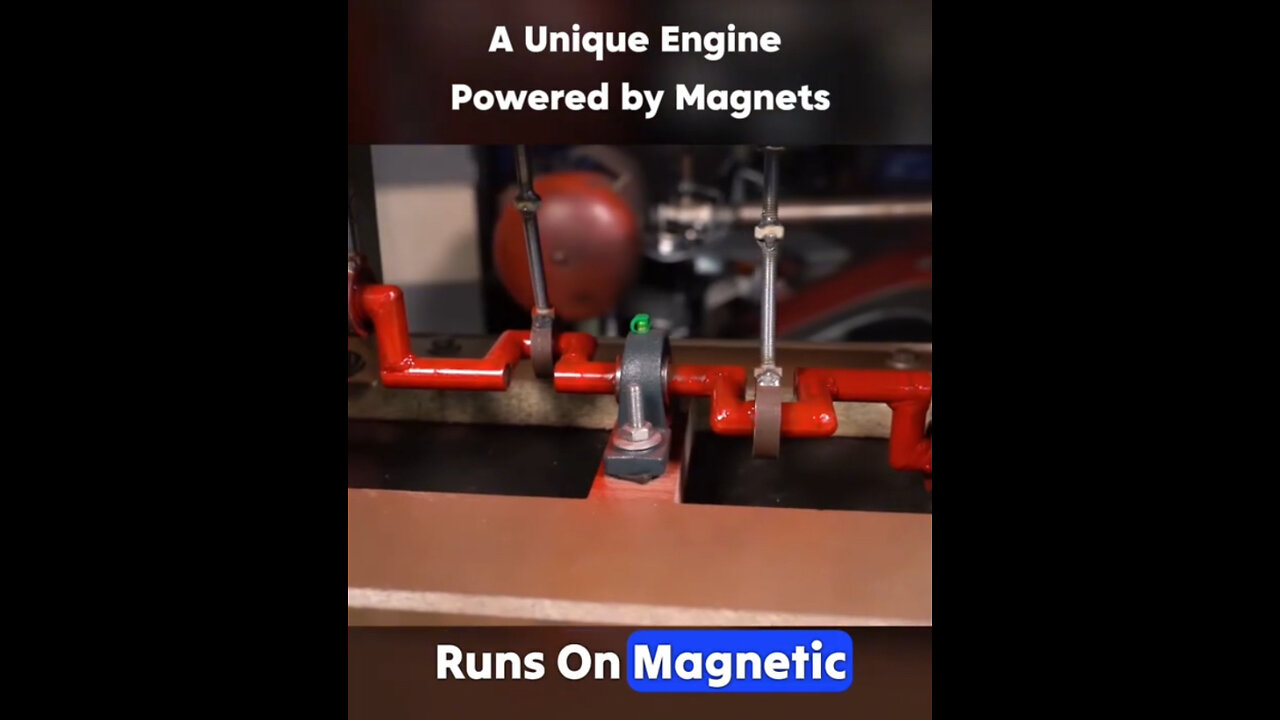Premium Only Content

Revolutionizing Motion: The Magnetic Engine and Its Potential to Reshape Energy
The world of engineering has long been driven by the quest for more efficient, sustainable, and innovative ways to power machinery. From steam engines to combustion engines, each step forward has brought us closer to achieving greater efficiency and reducing our reliance on finite resources. However, a new type of engine is emerging that promises to challenge conventional thinking and redefine what’s possible in the world of propulsion: the magnetic engine.
This engine—remarkable in its simplicity—uses magnetic repulsion as its core principle. Unlike traditional engines that rely on fuel, combustion, or electricity, this design operates solely on the inherent forces of magnets, making it not only fuel-free but potentially capable of running indefinitely. Let’s explore the mechanics, implications, and potential future of this groundbreaking innovation.
The Fundamentals: How the Magnetic Engine Works
At its core, the operation of this magnetic engine is deceptively simple. Rather than relying on fossil fuels, electrical currents, or any external energy source, this engine harnesses the power of magnetic fields—specifically, the repelling force between magnets of the same polarity. Here’s how it works:
1. The Design: The engine is constructed with essential components like a crankshaft, cylinder, and piston—elements typical of any internal combustion engine. However, in this case, the piston is made from magnetic material, which becomes the key to the engine’s motion.
2. Magnetic Repulsion: The engine’s operation is driven by strategically placed magnets. A magnet is fixed at the top of the piston, and another magnet of the same polarity is positioned above it. As magnets with the same polarity naturally repel each other, this repelling force drives the piston downward, creating the mechanical movement needed to power the engine.
3. Starting the Engine: Unlike traditional engines that require an ignition spark or a battery, the magnetic engine can be started with a simple push—just a shake of the hand to get the crankshaft turning. Once the engine is in motion, the magnets continue to provide the necessary force to keep the piston cycling.
4. Theoretically Infinite Motion: In theory, this engine could run indefinitely—as long as the magnets retain their strength. Since it doesn’t rely on a fuel source that can be depleted, and no combustion occurs to create wear and tear, the engine could potentially operate without stopping. The only limiting factor is the longevity of the magnets themselves, which, while long-lasting, will eventually degrade over time.
A New Paradigm: The Science of Magnetic Repulsion
The magnetic engine operates on the fundamental principle of magnetic repulsion. In physics, magnets exert forces on each other when placed in proximity. Magnets of like polarity (north-north or south-south) repel each other, while magnets of opposite polarity attract. In this engine’s design, the creators capitalize on this natural repelling force to generate motion without needing any external energy source.
Magnetic repulsion has long fascinated inventors and engineers. The challenge has been finding a way to effectively harness this force in a controlled manner to create sustainable, usable power. In this engine, by placing magnets of the same polarity at strategic points—both on the piston and above it—the creators have successfully converted this force into a reliable mechanism for driving the piston.
One of the key benefits of this system is its simplicity. Without the need for complex fuel systems, exhausts, or electrical wiring, the engine becomes easy to maintain, with fewer points of failure compared to traditional engines. Furthermore, because it generates no heat from combustion, the engine remains cool, reducing the need for cooling systems and increasing overall efficiency.
Applications and Potential of Magnetic Engines
Though still in its experimental stages, the magnetic engine has demonstrated potential applications in real-world scenarios, particularly where low-speed, high-efficiency engines are required. One of the most exciting prospects is using magnetic engines to power vehicles—as shown in early tests where this engine was installed in a car. While the vehicle moved at a slower speed than it would with a conventional engine, the fact that it could operate without fuel is a monumental leap forward in sustainable transportation.
However, the possibilities don’t stop there. Magnetic engines could find applications in various fields, such as:
1. Renewable Energy Solutions: Magnetic engines could complement existing renewable energy technologies, such as solar and wind power. By providing a reliable, fuel-free method of generating motion, magnetic engines could be integrated into systems that store or generate clean energy.
2. Small-Scale Machinery: Due to the simplicity of their design and operation, magnetic engines could be adapted for use in small-scale devices or machinery. This could be particularly useful in remote areas where access to fuel or electricity is limited, allowing for off-grid applications.
3. Sustainable Transportation: While current magnetic engines may not yet match the power output of gasoline or electric engines for high-speed vehicles, continued innovation could lead to improvements in speed and efficiency, making this a viable option for eco-friendly transport solutions.
4. Low-Energy Industrial Applications: Magnetic engines could provide power for low-energy industrial applications, such as conveyor belts, pumps, and other machinery that doesn’t require significant amounts of energy but operates continuously.
Challenges and Future Development
While the magnetic engine presents exciting possibilities, it is not without its challenges. One of the main limitations is the strength and longevity of magnets. While magnets are highly durable, they do lose their magnetic properties over time—a phenomenon known as magnetic decay. Over extended periods, the engine’s power could diminish as the magnets weaken, meaning that this design is not truly “infinite” in the long run.
Another challenge is scaling the technology. While the current design works well in small-scale demonstrations, scaling it up to power larger vehicles or machinery will require significant innovations. The magnetic forces needed to move heavier objects would require stronger magnets, and the design may need to be modified to handle greater loads.
Finally, there is the question of efficiency. While magnetic engines may offer a simple, fuel-free alternative, they may not yet provide the same level of power output as conventional engines. Further research and development are needed to improve the design, increase efficiency, and explore ways to enhance the magnet’s strength and durability.
The Future of Magnetic Engines: An Engine for a New Age?
The magnetic engine represents a fascinating innovation in the search for sustainable, clean energy solutions. Its reliance on magnetic forces instead of fuel offers a glimpse into a future where machinery operates with little environmental impact, drastically reducing reliance on finite resources like oil and gas.
While there is still much work to be done, the magnetic engine opens up exciting new possibilities in engineering and renewable energy. If the challenges of magnetic decay, scalability, and efficiency can be addressed, this technology could revolutionize not just transportation, but the way we think about energy and motion as a whole.
For now, the magnetic engine is a proof of concept—a glimpse into what might be possible with further innovation. It stands as a testament to human ingenuity and the relentless drive to create a world where sustainable energy is not just an aspiration, but a reality.
-
 22:47
22:47
FragmentsOfTruth
5 days agoInside America’s Most Secretive Agency: The CYFD Scandal They Don’t Want You Filming
3091 -
 LIVE
LIVE
Dr Disrespect
7 hours ago🔴LIVE - DR DISRESPECT'S TRIPLE THREAT CHALLENGE - ARC RAIDERS • BF6 • FORTNITE
1,149 watching -
 1:00:57
1:00:57
Russell Brand
4 hours agoThe Vaccine Ideology Unmasked | Dr Peter McCullough - SF658
88.5K33 -
 1:11:25
1:11:25
vivafrei
3 hours agoKash Patel's Jacket-Gate! Pfizer Whistleblower Qui Tam on Appeal! Meanwhile in Canada! AND MORE!
42.7K27 -
 16:30
16:30
Clintonjaws
7 hours ago $2.30 earnedEntire Room Speechless as Pete Hegseth Snaps Destroying All Media To Their Face
12.9K8 -
 22:12
22:12
Dad Saves America
3 hours agoHow Greek Philosophers Created Western Civilization: The Death of Debate - Pt 2
3.28K -
 LIVE
LIVE
LFA TV
20 hours agoLIVE & BREAKING NEWS! | WEDNESDAY 12/03/25
1,212 watching -
 1:05:46
1:05:46
The Quartering
4 hours agoNew Epstein Video Drops! The US Economy Has SCARY Numbers Released & More
116K26 -
 1:07:11
1:07:11
The White House
7 hours agoPresident Trump Makes an Announcement, Dec. 3, 2025
32K18 -
 1:26:28
1:26:28
Film Threat
23 hours agoINSIDE THE DECLINE OF DISNEY! A WARNING FROM THE PAST | Hollywood on the Rocks
14.9K1